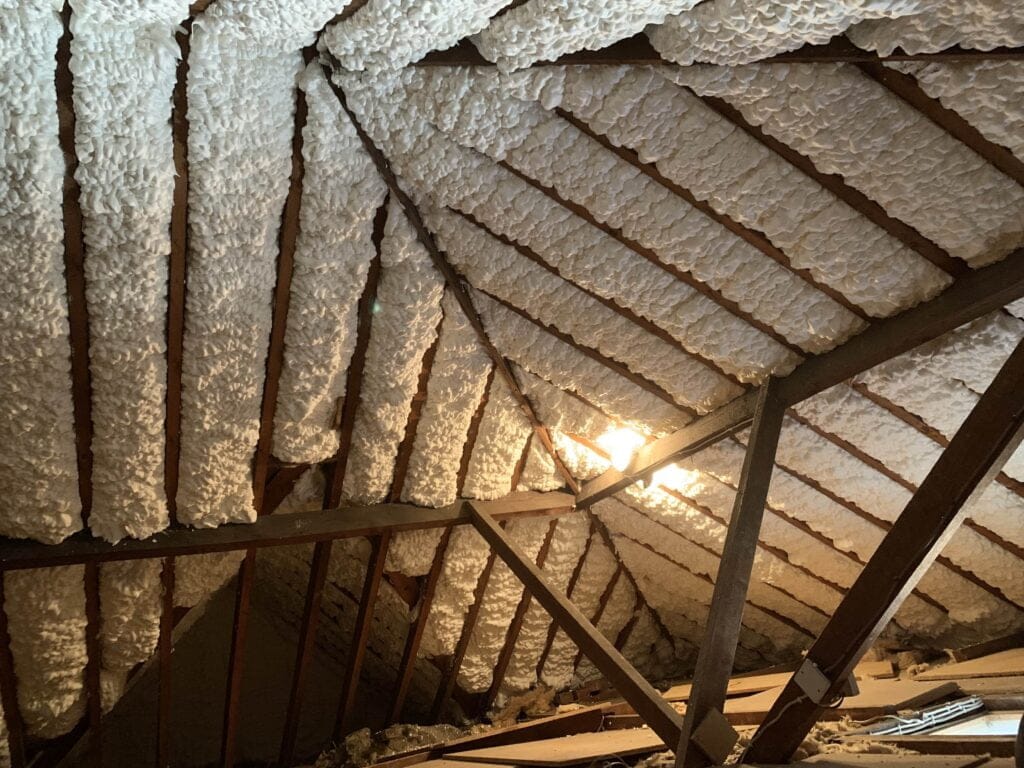Proper roof insulation significantly extends roofing material lifespan by controlling temperature fluctuations and preventing moisture-related damage. Insulation acts as a thermal barrier that reduces extreme heat buildup in summer and prevents ice dam formation in winter, both major causes of premature roof deterioration. Well-insulated roofs experience 30-50% less thermal stress, directly translating to extended material lifespan and reduced replacement frequency.
The protection mechanism works through temperature regulation and moisture control. Insulation prevents rapid heating and cooling cycles that cause roofing materials to expand and contract repeatedly, leading to cracks, warping, and structural failure. Additionally, proper roof insulation solutions eliminate condensation problems that cause rot, mold, and premature aging of roof components.
Temperature Control Mechanisms
Roof insulation creates a stable thermal environment that protects roofing materials from destructive temperature swings. During summer months, uninsulated roofs reach surface temperatures exceeding 160°F, while properly insulated roofs maintain more moderate temperatures around 120°F. This 40-degree reduction prevents thermal shock that damages shingles, tiles, and membrane materials.
Winter protection proves equally important for material preservation. Insulation prevents heat loss from living spaces that would otherwise melt snow on the roof surface. This controlled environment eliminates freeze-thaw cycles that crack and split roofing materials over repeated seasonal transitions.
Bonus Tip: Monitor attic temperatures during extreme weather to verify insulation effectiveness. Temperature differences between indoor and outdoor readings should remain consistent throughout seasonal changes.
Moisture Prevention and Control
Effective insulation systems include vapor barriers and proper ventilation that prevent moisture accumulation within roof assemblies. Moisture represents the primary enemy of roofing longevity, causing wood rot, metal corrosion, and material degradation across all roofing types.
Condensation occurs when warm, humid air contacts cold surfaces within the roof assembly. Proper insulation placement and vapor barrier installation prevent this contact, maintaining dry conditions that preserve structural integrity. Controlled moisture levels extend material lifespan while preventing costly repairs and premature replacement needs.
| Moisture Source | Impact on Roof Materials | Prevention Method |
| Interior Humidity | Wood rot, metal corrosion | Vapor barriers |
| Temperature Differential | Condensation damage | Proper insulation thickness |
| Air Leakage | Ice dam formation | Complete air sealing |
| Inadequate Ventilation | Trapped moisture | Balanced intake/exhaust |
| Seasonal Changes | Freeze-thaw damage | Consistent thermal barrier |
Roofing Material Longevity Comparison
Different roofing materials respond uniquely to insulation benefits, with some materials showing more dramatic lifespan improvements than others. Understanding these differences helps prioritize insulation investments based on existing roof types.
| Roofing Material | Standard Lifespan | With Proper Insulation | Lifespan Extension | Primary Benefit |
| Asphalt Shingles | 15-20 years | 25-30 years | 50-65% | Reduced thermal cycling |
| Metal Roofing | 40-50 years | 60-70 years | 40-50% | Prevents condensation |
| Clay Tiles | 50-60 years | 75-100 years | 50-65% | Eliminates freeze-thaw |
| Slate | 75-100 years | 100-150 years | 25-50% | Structural support |
| EPDM Membrane | 20-25 years | 30-40 years | 50-60% | UV protection |
Research conducted by roofing industry associations shows properly insulated roofs require 40% fewer repairs during their service life compared to inadequately insulated systems. This data reflects reduced maintenance costs and fewer emergency interventions over the roof’s operational period.
Thermal Cycling Damage Prevention
Repeated expansion and contraction cycles cause fatigue stress in roofing materials, leading to cracks, splits, and connection failures. Insulation moderates these temperature changes, reducing mechanical stress that accumulates over thousands of daily cycles.
Material expansion rates vary significantly with temperature changes, creating differential movement within roof assemblies. Insulation maintains more consistent temperatures, reducing these differential movements and preserving material integrity over extended periods.
Technical Specifications for Roof Protection
Insulation requirements vary by climate zone and roofing material type to provide optimal protection benefits. Proper R-value selection ensures adequate thermal protection while maintaining cost-effectiveness for specific applications.
| Climate Zone | Minimum R-Value | Recommended R-Value | Vapor Barrier Required | Ventilation CFM/sqft |
| Zone 1-2 | R-30 | R-38 | Not required | 1/150 |
| Zone 3-4 | R-38 | R-49 | Recommended | 1/150 |
| Zone 5-6 | R-49 | R-60 | Required | 1/300 |
| Zone 7-8 | R-60 | R-70+ | Required | 1/300 |
Installation depth and coverage completeness directly impact protection effectiveness. Gaps, compression, and inadequate thickness reduce thermal performance, allowing temperature fluctuations that damage roofing materials. Professional installation ensures consistent coverage that maximizes protection benefits.
Ice Dam Prevention Through Insulation
Ice dams form when inadequate insulation allows heat loss that melts snow unevenly across roof surfaces. The resulting ice accumulation creates water backup that penetrates roofing materials, causing extensive damage to shingles, decking, and interior components.
Proper insulation prevents ice dam formation by maintaining consistent roof surface temperatures. This uniform thermal environment eliminates the melting and refreezing cycle that creates dangerous ice accumulations along roof edges and gutters.
Bonus Tip: Combine adequate insulation with proper ventilation for maximum ice dam prevention. Both components work together to maintain ideal roof temperatures throughout winter conditions. Energy Efficiency and Material Protection
Energy Efficiency and Material Protection
Energy-efficient insulation systems provide dual benefits through reduced utility costs and extended roofing material lifespan. Lower energy consumption reduces the overall cost of roof ownership while protection benefits minimize replacement and repair expenses.
Market analysis indicates homeowners save an average of 15-25% on heating and cooling costs with properly insulated roofs. These savings, combined with extended material lifespan, provide compelling financial returns on insulation investments within 3-5 years.
Common Questions About Roof Insulation Benefits
Property owners frequently ask about specific protection mechanisms and expected lifespan improvements when considering insulation upgrades. Understanding these common concerns helps evaluate insulation investments for existing roof systems.
Does insulation thickness affect protection benefits? Yes, adequate thickness ensures complete thermal separation between interior and exterior environments. Insufficient insulation allows temperature fluctuations that reduce protection effectiveness.
Can insulation be added to existing roofs? Most roof types accommodate insulation upgrades through attic installation or exterior application methods. Professional assessment determines the best approach for specific roof configurations.
How quickly do protection benefits begin? Insulation provides immediate thermal protection upon installation. Material preservation benefits accumulate over time as reduced thermal stress prevents gradual deterioration.
Things to Consider Before Making a Decision
Roof age and condition influence insulation investment priorities and expected benefits. Newer roofs gain maximum lifespan extension through early insulation installation, while older roofs may require repair or replacement before insulation provides optimal value.
Building design and ventilation systems affect insulation performance and protection benefits. Proper air sealing and ventilation balance ensure insulation works effectively without creating moisture problems or thermal bridging issues.
Local climate conditions determine insulation requirements and expected protection benefits. Extreme temperature regions show greater material preservation improvements compared to moderate climate zones with less thermal stress.
Bonus Tip: Schedule insulation installation during roof replacement or major repair projects. Combined work reduces overall costs while ensuring integrated system performance.
Long-term Economic Benefits
Insulation investments provide measurable returns through extended material lifespan and reduced maintenance requirements. Roof replacement costs typically range from $8,000-25,000 for residential properties, making lifespan extension extremely valuable for long-term property ownership.
Insurance claims data shows properly insulated roofs experience 60% fewer weather-related damage claims compared to inadequately insulated systems. This protection translates to lower insurance premiums and reduced out-of-pocket repair costs over the roof’s service life.
Roof Insulation FAQ
How much longer will my roof last with proper insulation? Most roofing materials experience 40-60% lifespan extension with adequate insulation. Actual improvements depend on material type, climate conditions, and installation quality.
What type of insulation works best for roof protection? Spray foam provides superior air sealing and thermal protection, while fiberglass and cellulose offer good performance at lower costs. Material selection depends on budget, climate, and installation requirements.
Does insulation prevent all roof damage? Insulation prevents temperature and moisture-related damage but cannot protect against physical impacts, manufacturing defects, or installation errors. Regular maintenance remains important for comprehensive roof protection.
When should I add insulation to my existing roof? Install insulation as soon as possible for maximum protection benefits. Early installation provides the greatest lifespan extension and return on investment compared to waiting until materials show damage.
Can DIY insulation installation provide the same protection benefits? Professional installation ensures proper coverage, air sealing, and vapor barrier placement that maximize protection effectiveness. DIY installations often have gaps and deficiencies that reduce benefits. Make the Right Decision
Make the Right Decision
Roof insulation represents one of the most cost-effective methods for extending roofing material lifespan while reducing energy costs. The thermal protection and moisture control benefits begin immediately and accumulate over decades of improved roof performance.
Evaluate your current roof condition, local climate requirements, and long-term ownership plans when considering insulation investments. Professional assessment identifies the most effective insulation strategy for your specific situation, ensuring maximum protection benefits and financial returns.
Prestige Insulation Solutions LLC
Contact: 850 429-4969
Reviewer
Reviewer: With over 13 years in spray foam insulation, Benjamin Lee reviewed this content and offered feedback aimed at helping growing businesses connect with local homeowners and commercial clients more effectively.









